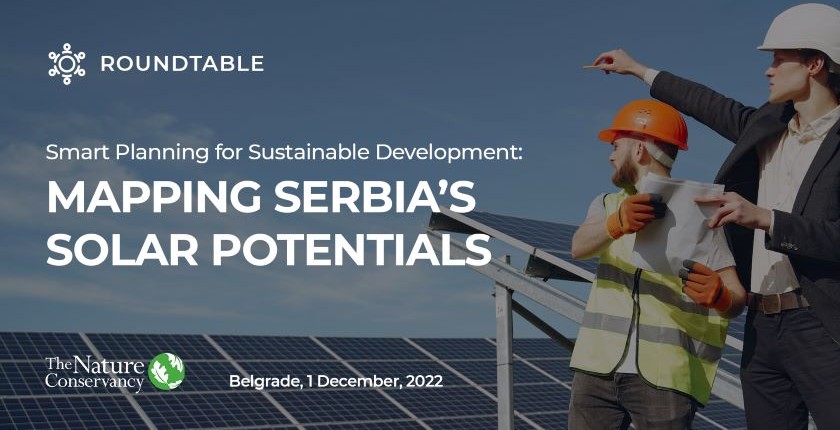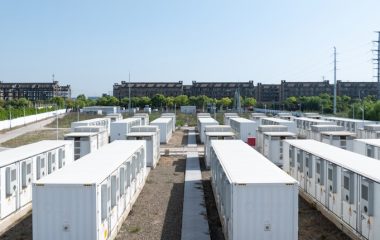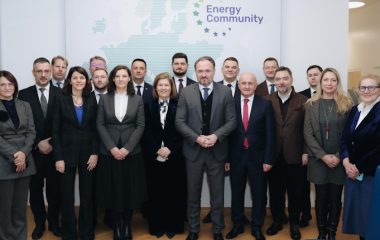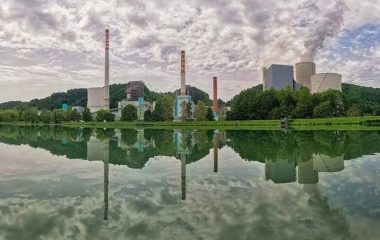
Photo: The Nature Conservancy
Share
A roundtable within the project Smart Planning for Sustainable Development: Mapping Serbia’s Solar Potentials will be held in Belgrade on December 1, 2022. At the event, organized by The Nature Conservancy, officials of relevant institutions, stakeholders, and investors will be introduced to possibilities for speeding up solar energy development in Serbia through the development of specific locations for photovoltaic power plants.
The Mapping Serbia’s Solar Potentials project was carried out by members and associates of The Nature Conservancy (TNC), with the aim of identifying potential locations for solar power plants in Serbia using the Geographic Information System (GIS).
Representatives of relevant state institutions, the civil sector, the industry, and investors are invited to join the roundtable on the potentials for developing solar power plants in Serbia.
Sites for building 1 GW of solar power plants
The project team was tasked with designating a total of 100 sites with the potential to build a solar photovoltaic power plant with a capacity of up to 10 MW, which would help increase the capacity for green energy production in Serbia by 1 GW.
For these projects to be sustainable, potential sites need to meet specific environmental, economic, social, and technical criteria
For these projects to be sustainable, potential solar power plant sites need to meet specific environmental, economic, social, and technical criteria, and also to enable high performance with minimal costs and minimal negative impacts on the environment.
On the one hand, it is necessary to preserve resources for food production, biodiversity, and the visual quality of the area, while at the same time positioning solar power plants in areas with high values of solar radiation, and near existing electricity grids, roads, places of consumption, etc.
It is imperative to ensure energy security
Amid the global energy crisis, Serbia, like all other European countries, is under the imperative of ensuring energy security for its citizens and industry. That can be achieved systemically, with long-term planning to accelerate the construction of solar and wind power plants as the fastest and probably the cheapest investment option. That option does not include dependence on imported energy products, does not pollute the environment, and uses natural and renewable resources Serbia has in abundance.
Vejnović: the mapping aims to select locations with minimal impact on people and the environment
“We want to show that through a smart mapping of photovoltaic power plants and with cooperation between the state, energy companies, and civil society, a solution can be reached that attracts investors while at the same time protecting the public interest. The mapping aims to select locations with minimal impact on people and the environment, so as to reduce the risk of the planned power plants endangering natural and cultural heritage of Serbia, or hindering other strategic economic activities such as agricultural production,” said Igor Vejnović, Director of Strategic Initiatives of the South East Europe Program at The Nature Conservancy.
Project partners and stakeholders
The Nature Conservancy, during the implementation of the project, cooperates with institutions of the Republic of Serbia, as well as other organizations and associations that can help identify sustainable locations for the construction of solar power plants.
Among the stakeholders that can contribute to a sustainable development of solar energy in Serbia are the Government of the Republic of Serbia and relevant ministries, public companies in the energy sector, local self-governments, the academic community, investors in solar power plants, civil society organizations, and the media.
Incentives for solar power development
After Serbia adopted the Law on the use of renewable energy sources in 2021, a new wave of investments was launched in the construction and development of solar power plants. In addition to rooftop power plants installed by households and businesses, a significant portion of the investments in going towards building ground-mounted solar power plants with larger capacities.
The key motivation for mapping Serbia’s solar potential is to speed up the sustainable use of solar energy in the country
The key motivation behind the mapping of Serbia’s solar potential is to accelerate the sustainable use of solar energy in the country, thus providing significant support to the energy transition and energy security of Serbia, and helping tackle the current energy crisis, according to The Nature Conservancy.
An important segment of the project is the Green Dialogue within workshops that were held throughout Serbia, as well as the announced roundtable on December 1 in Belgrade, where initial results of the project will be presented and further steps announced.









Be the first one to comment on this article.